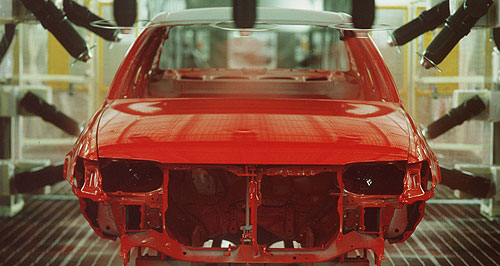Make / Model Search
News - General News - PartsPPG paint strike hangs over industryLeft: PPG Industries staff striking at the companies Clayton, Victoria, factory. Car-makers say paint factory dispute is not hurting production – for now7 Apr 2011 AUSTRALIA’S car-makers say it is business as usual at their factories, despite a two-week-old industrial dispute at major auto paint supplier, PPG Industries Australia. The American-owned company has been accused of strike busting by bringing in 110 workers – including 20 from overseas – to maintain production at the plant, where about 90 per cent of workers voted to strike in February and walked out on March 28. The dispute centres around a proposal by the company to hire any new workers at a lower pay rate, which the union, United Voice, says amounts to pay cuts of up to 43 per cent. PPG maintains that existing workers – which it says get paid over-award wages of up to $100,000 – were not being asked to take a pay cut at the factory that supplies all of Ford’s paint supplies and a large slice of paint for Holden and Toyota. The Herald Sun quoted PPG spokesman Jon Smiles as saying: "We are happy for current employees to keep what they have. "What we have said, and we have been saying it for four months, is that compared to our nearest competitor we pay 43 per cent more for comparable jobs."  From top: Australian-built Holden Ute, Ford Falcon, Toyota Camry cars. From top: Australian-built Holden Ute, Ford Falcon, Toyota Camry cars.Mr Smiles reportedly said the company’s Clayton factory in Victoria was producing more paint now than it had with its regular workforce, and that paint supplies were not threatened. Striking workers say the strike-breakers’ training levels are sub-standard. Health and safety representative Gary Farley, who has worked at the Clayton plant for 24 years, said: “These casual workers do not get the training that the rest of us get in the job. “They wouldn’t be anywhere as efficient as the regular workers, so they wouldn’t be able to keep up the same pace. And then there the obvious safety issues.” United Voice assistant Victorian secretary Ben Redford said PPG’s actions were threatening the jobs of “thousands upon thousands” of people in the car industry, which could be disrupted if the company could not fill its orders without the expertise of its highly-skilled local workforce. “And the fact that the people it has imported to break the strike have sub-standard training shows that PPG is more interested in its profits than its clients or its workers,” he said. “Bringing in strike-breakers instead of negotiating with workers also recalls some of the worst days of the waterfront dispute.” Mr Redford said that all the local workers wanted was a fair pay rise. “Their wages have not increased since 2009. But PPG have showed little interest in genuinely negotiating and have resorted instead to US-style union busting. It is un-Australian,” he said. About 120 workers voted to go on strike over the dispute, with PPG reportedly bringing in 110 to replace them. The union says the 20 overseas workers are believed to have arrived from the United States. Contacted by GoAuto, Toyota, Ford and Holden spokespersons confirmed that their factories in Adelaide and Melbourne had sufficient paint to continue production, and that they did not anticipate any interruption in the short term. Toyota Australia spokesman Glenn Campbell reported no immediate effect on production at its Altona plant in Merlbourne, but added that the company was closely monitoring the situation. He said PPG was one of two suppliers providing paint for Camry and Aurion production. The PPG dispute comes on top of concerns about potential disruption of parts supplies from Japan following that nation’s devastating earthquake and tsunami on March 11. Negotiations between the union and PPG are said to be continuing.  Read more |
Click to shareGeneral News articlesResearch General News Motor industry news |










Facebook Twitter Instagram